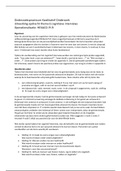Exam (elaborations)
Psychology A* essay - get top grades now!
- Institution
- WJEC
Struggling with your essay response? Fear not! Our 5 model answer response to topics questions on sexism, non-human animals, and the ethical cost of scientific research in Psychology can help you write your PERFECT essay. By studying our model answers, you will gain the necessary guidance and insig...
[Show more]












